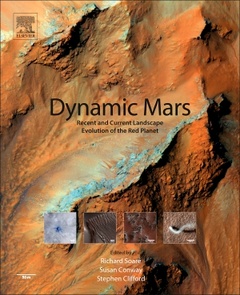Dynamic Mars Recent and Current Landscape Evolution of the Red Planet
Coordonnateurs : Soare Richard, Conway Susan, Clifford Stephen M.

Highly illustrated and punctuated by data from the most recent Mars missions, Dynamic Mars is a valuable resource for all levels of research in the geological history of Mars, as well as of the three other terrestrial planets.
Late Amazonian Epoch climate 1. Orbital (climatic) forcing and its imprint on the global landscape Recent surface water at/near the mid-latitudes? 2. Unraveling the mysteries of recurring slope lineae (RSL) 3. Gullies and their connection with the climate 4. Recent fluvial-channels, -landforms and fresh shallow-valleys in the Olympus Mons lava plains
The Polar Regions 5. Active geomorphological processes involving exotic agents 6. CO2-driven geomorphological processes
Glacial and periglacial landscapes 7. Paleo-periglacial and “ice-rich complexes in Utopia Planitia 8. Bi-hemispheric (periglacial) mass wasting
Volcanism 9. Volcanic disruption of recent ice-deposits in the Argyre Basin
Aeolian processes 10. Dust devils: stirring up the surface 11. Dark Dunes of Mars: An orbit-to-ground multidisciplinary perspective of aeolian science
Other surface-modification processes 12. Modification of the surface by impact cratering 13. Stone pavements, lag deposits, and contemporary landscape-evolution 14. Karst landforms as markers of recent climate change: en example from the late Amazonian Epoch evaporite karst within a trough in western Noctis Labyrinthus
Richard Soare is a physical geographer specializing in periglacial (cold-climate, non-glacial landscapes). Through the last twenty years he has spent considerable time in the Canadian arctic (physically) and off-planet (intellectually), attempting to identify landscapes on Mars present or past possibly molded by the freeze-thaw cycling of water. His work spans the red planet geographically, ranging from the plains of Utopia Planitia in the northern hemisphere and the Moreux impact-crater at the Mars dichotomy through to the Argyre impact-crater in the southern hemisphere. Recently, he lead-edited “Mars Geological Enigmas: from the late Noachian Epoch to the present day and a special issue of Icarus: “Current and Recent Landscape Evolution on Mars.
Susan Conway is a CNRS research scientist in Nantes, France, having graduated with a PhD in planetary science from the Open University (United Kingdom) in 2010. She is chair of the International Association for Geomorphologists (IAG) Planetary Geomorphology Working Group, and has run the Planetary Geomorphology session at the European Geoscience Union since 2011. She is lead editor for a collection of papers on Martian gullies and their Earth analogues, based on the workshop she organized at the Geological Society of London in June 2016 and is co-editor on a collection of papers entitled "Frontiers in Geomorphometry". She is a team member on the High Resolution Imaging Science Experiment (HiRISE) instrument on NASA's Mars Reconnaissance Orbiter and Guest Investigator on the ESA Trace Gas Orbiter mission to Mars, specifically focused on the CaSSIS camera and NOMAD/ACS spectrometer instruments. She is on the author list of 35 peer-reviewed papers concerning the geomorphology of Earth, Mars, Mercury, the Moon and the asteroid Vesta. Her work is concentrated around glacial, periglacial and fluvial landforms on Mars, encompassing field, remote sensing and laboratory simulation data, with a spe
- Utilizes observational and model-based data as well as geological context to frame the understanding of the dynamic surface and near-surface of Mars
- Presents a broad spectrum of highly regarded experts and themes to discuss and evaluate the geological history of late and current Mars
- Includes extensive and detailed imagery to clearly illustrate these themes, discussions, and evaluations
Date de parution : 08-2018
Ouvrage de 474 p.
19x23.3 cm
Thèmes de Dynamic Mars :
Mots-clés :
Aeolian; Araneiforms; Argyre; Bagnold dune field; Brines; Carbon dioxide; Channels; Clast weathering; Climate change; CO2Dendrites; CO2Gas; Corinto; Craters; Creep; Cumulic pedogenesis; Curiosity rover; Deflation; Dune; Ejecta; Fluvial; GCM; Geomorphology; Granular flow; Ground ice; Groundwater; Habitability; HiRISE; Ice; Impacts; Karst; Kieffer's model; Knudsen pump; Lag deposits; Landscape evolution; Late Amazonian; Lava; Layered deposits; Liquid water; Lobate forms; Mars; climate; Mars; polar geology; Mars; surface; Mars; Martian gullies; Noctis Labyrinthus; Polar processes; Recurring slope lineae; Saltation; Seasonal process; Seasonal processes; Secondary craters; Solid-state greenhouse effect; Solifluction; Stone pavements; Streamlined island; Sublimation lag; Sublimation; Tectonics; Volatiles; Volcanism; Wash; Weathering lag; Yardang



